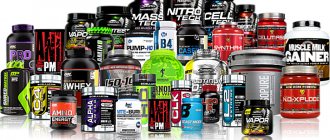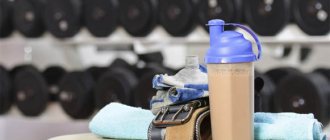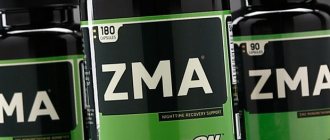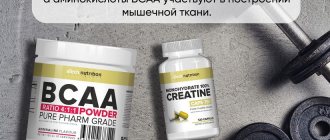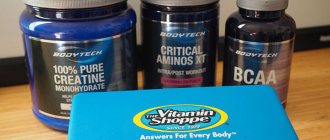Chemistry in bodybuilding
Let's first figure it out: what exactly do I call “chemistry”? And by “chemistry” I mean drugs that affect an athlete’s hormonal levels or imitate the effect of a hormone.
To complete the picture, let’s try to understand what hormones are. Hormones are biologically active substances produced in various glands. Once in the blood, they reach target cells (muscle tissue, skeleton, brain, etc.) and, reacting with these cells, activate various processes. Those. With the help of hormones, the body regulates all the processes occurring in it: our character (impulsiveness), height, weight, muscle volume, sexual characteristics, etc. depend on them. The role of the hormonal system is to adapt the body to various conditions (physical activity, stress). This is a very complex and organized process and interference in it, by definition, does not bring anything good.
So, let's return to the topic of “chemistry”. By “chemistry” we most often mean anabolic steroids – a synthetic analogue of the male sex hormone (testosterone and dihydrotestosterone). They are a medicine and are used for various diseases or after operations. Let's figure out why anabolic steroids have become so popular among athletes.
The anabolic effects of steroids include: an increase in muscle mass (due to the acceleration of protein synthesis), an increase in performance, and an increase in strength. In view of the fact that anabolic steroids are, in fact, the same testosterone, the effects of their use can be added to: increased libido (self-esteem), dulled feelings of fear, sociability, attentiveness, increased potency. In general, while taking anabolic steroids you will feel like a superman, but after finishing the course all these effects will disappear, because of this, many athletes develop a strong psychological dependence. Also, after long-term use and non-compliance with dosages, the production of your own hormone may be disrupted, so negative side effects may also appear: prostate inflammation, testicular atrophy, impotence, liver damage. Athletes often resort to so-called “post-cycle therapy” - the use of various drugs in order to minimize the effects of taking steroids and normalize hormonal levels.
As for the “I’ll drink once and quit” approach, you shouldn’t do that, because... the result from using such drugs after completing the course tends to quickly “evaporate”, therefore, in order to maintain shape, you will have to take more than one course. Steroids give a temporary effect, and if there is no professional need to have a “very cool” body and you are working out for yourself, it is better to abandon the idea of \u200b\u200busing various anabolic steroids.
growth hormone has now become very popular . It increases lean muscle mass and promotes fat burning. Growth hormone is not an anabolic steroid, because... is a peptide hormone, but in bodybuilding it is often taken together with them. Growth hormone has fewer side effects and a lower frequency of their occurrence, but is a very expensive drug.
There is also such a thing as various testosterone boosters - supplements that are designed to increase the secretion of your own testosterone in the body. These drugs are classified as sports nutrition and are sold absolutely legally in stores. It is generally accepted that they are absolutely harmless, but, as stated above, hormones are not to be trifled with in any case. These are certainly not steroids, but playing with any drugs that affect testosterone production does not lead to anything good.
Popular sports “chemistry” and the harm from it
Conventionally, all “chemistry” can be divided into two large groups:
- something that you can drink and that will not cause a sharp increase in muscle mass (protein, l-carnitine, BCAA, fat burners)
- something that needs to be injected and causes a sharp increase in muscle volume (anabolic steroids)
First group
The most popular among beginners, who hasn’t drank a delicious protein shake after a tiring workout?
Amino acids, BCAA, carnitine are also useful so that the body does not waste energy on producing its own acids, does not catabolize muscles obtained with such difficulty, and most importantly, immediately and effectively recovers for the next workout. For example, the popular combination of BCAA and protein, with long-term hard training and a proper diet, can make the most popular dream come true - “transfer fat into muscle,” i.e. lose fat through long cardio workouts and prevent the muscles you have grown from burning off.
However, pitfalls in the form of stress on the kidneys, deterioration of digestion in the gastrointestinal tract, and disruption of the cardiovascular system can become your companions in case of overdose of even these seemingly harmless drugs.
Processing large amounts of protein, as happens when taking protein, can put a lot of stress on the kidneys, excessive amounts of amino acids will impair digestion, and l-carnitine and other generics, so-called “pre-workouts” and caffeinated fat burners will cause significant damage to your heart. Therefore, strictly monitor the dosages and buy drugs only from trusted companies: Muscletech, Dymatize, BSN.
Second group
Consisting of anabolic steroids, such as: testosterone (cypionate), dianabol, turinabol, nandrolone, sustanon, trenbolone, with incorrect dosage and lack of PCT - post-cycle therapy, will cause significant damage to your body.
Of course, these drugs will allow you to quickly acquire a large amount of lean muscle mass, become the owner of a beautiful relief and completely update your wardrobe by buying clothes several sizes larger, because the pressure will begin not in the stomach, but in the shoulders.
However, having agreed to use this group of drugs, experienced athletes are advised to first do a full medical examination and consult with a doctor about the general tolerability of anabolic steroids and the effectiveness of PCT.
If you are not attentive enough to all this, you chase the result and do not follow the dosage, do not follow the duration of the course and proper nutrition, then the side effects from the first group will seem like flowers to you.
The most common side effects from anabolic steroids can be considered the following:
- liver adenoma (due to frequent use of cheap and low-quality anabolic steroids and long courses of use)
- gynecomastia , a benign tumor of the nipples in men (everyone remembers the movie “Fight Club”
- acne (especially on the back and shoulders, and especially when taking highly androgenic drugs. Thus, experienced “chemists” are easily identified by a large red rash on the back)
- baldness (due to decreased natural testosterone production)
- testicular atrophy , impotence (due to decreased natural gonadotropin production)
- blood clot formation (increased blood clotting)
A course of PCT, which will actually allow you to avoid all of the above horrors, very often is fraught with “kickback”, i.e. all the volumes gained with such a risk can be lost when taking antiestrogens, so it’s up to you to take the “heavy artillery” and then risk “rolling back.”
Can sports nutrition be called “chemistry”?
Hi all! The topic of the article is sports nutrition. Is it useful or maybe harmful? What myths exist about this? How to use sports nutrition to add muscle mass or improve other athletic performance? We will discuss all these issues today.
So, sports nutrition. This topic is perhaps one of the hottest and most widely discussed on the Internet if we talk about topics related to appearance, bodybuilding, bodybuilding and so on. Perhaps the only hot topic is the use of anabolic steroids.
There are so many tales floating around on the Internet, at least about such a simple and familiar protein, as well as about amino acids, creatines, fat burners and other gainers. These words alone can make the heart of the average person tremble and shrink with horror. In his mind, anabolic steroids, sports nutrition, prohibited additives, harm to health – these are concepts that he brushes under the same brush and is ready to equate. However, the reader of this material, as a reasonable person, is able to figure it out on his own and will try to find some halftones, because the world does not have to be seen only in black and white - there are always some intermediate points that it would be nice to understand.
Often, ignorant people attribute many harmful consequences to sports nutrition, calling sports nutrition “chemicals.” What do they mean by the concept of “chemistry” if we are talking about sports nutrition? People imagine something unnatural, something unnatural that causes harm to your body.
But let's figure out what, in general, “chemistry” is? Do you know that any ketchups, sauces, mayonnaise, canned food are one hundred percent food chemicals that surround us everywhere? However, don't be afraid. Let's clear some things up.
The fact is that every second hundreds of thousands of different processes take place in the human body, one way or another related to chemistry. These are different chemical reactions. With the help of some substances they flow faster, with the help of other substances they slow down. Our body is like a chemical laboratory. With the help of these reactions, a person breathes, eats, ruins his health with the help of nicotine or alcohol, enjoys sex, and enjoys food.
In general, all this can be called in one simple word - this is life, this is our existence, and it is entirely inextricably linked with chemistry. Why? Yes, because all processes that occur at the molecular level are directly related to various chemical elements.
In other words, our body is a large chemical laboratory. Hundreds of thousands of different chemical reactions occur in it every second. To pass them, hundreds of chemical elements are needed, which we are forced to obtain from food.
Let's speculate. So, today a man went to the store. He goes to the produce department to buy himself something for lunch. More recently, some couple of thousand years ago, the population of the globe was very insignificant - some several million homo sapiens. It was quite easy to feed such a small number of people. For this purpose, as a rule, pasture was used; our ancestors were engaged in gathering and hunting. That is, they took what they could take by reaching with their hand.
But people, like locusts, like rats, or like other species limitless in their expansion, began to multiply and multiply, which led to a limitation of the natural amount of food. Then agriculture and animal husbandry arise as ways to increase the existing amount of food. The only problem is that a person cannot stop - he needs to be fruitful and multiply, multiply and multiply ad infinitum.
And what's the result? As a result, until the mid-twentieth century, the Earth was shaken by famine and food shortages. And then fertilizers enter the arena. These are a kind of “doping” for the soil. Without all these nitrates, phosphates and other delights, we simply would not receive crops in such quantities to feed our existing mouths. And let's be honest: this “chemistry” saved many lives. So gradually, slowly, “chemistry” crept onto the shelves of our vegetable departments.
Okay, the buyer goes to his favorite department, which sells milk or cottage cheese. The buyer consoles himself with the hope that the cow ate only hay and grass in the village, because such a picture is depicted on the tetrapack. He is mistaken! Various feedstuffs, vitamin-mineral complexes, and often hormonal therapy are what make it possible to improve the quality and quantity of products in the livestock sector. That is why all this has been used since the middle of the last century. This applies not only to milk, as you understand, but also to meat.
And now readers of this material will be surprised in a big way. There is one chemical product that has one of the most aggressive chemical anions, which is sold in almost every grocery store and which, most likely, every citizen has at home. But for some reason no one shouts that this is “chemistry”.
We are talking about sodium chloride - sodium chlorine. This is an inorganic sodium metal salt or simply table salt. But why is no one afraid of her? After all, this is a rather aggressive chemical element. Maybe because people are well versed in the chemical properties and structure of this element? It is unlikely. This question will be answered later.
